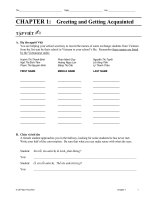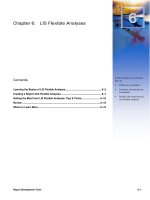Tài liệu Chapter 6: Force and Motion II docx
Bạn đang xem bản rút gọn của tài liệu. Xem và tải ngay bản đầy đủ của tài liệu tại đây (395.82 KB, 10 trang )
Chapter 6
Force and Motion II
In
this chapter we will cover the following topics:
Describe the frictional force between two objects. Differentiate
between static and kinetic friction, study the properties of friction, and
introduce the coefficients for static and kinetic friction.
Study the drag force exerted by a fluid on an object moving through the
fluid and calculate the terminal speed of the object.
Revisit uniform circular motion and using the concept of centripetal force
apply Newton’s second law to describe the motion.
(6-1)
We can explore the basic properties of friction
by analyzing the following experiment based on our every
day experience. We have a heavy crate resting on the floor.
We push the crat
Friction:
e to the left (frame b) but the crate does not
move. We push harder (frame c) and harder (frame d) and
the crate still does not move. Finally we push with all our
strength and the crate moves (frame e). The free body diagrams
for frames a-e show the existence of a new force which
balances the force with which we push the crate. This force
is called static frictional fothe . As we increase ,
rce
s
s
f
F
F
f
r
r
also increases and the crate remains at rest. When reaches
a certain limit the crate "breaks away" and accelerates to the left.
Once the crate starts moving the force opposing its motion is
called th
F
e . . Thus if we wish the
crate to move with constant speed we must decrease so that it
balances (frame f). In
kinetic frictional force
frame (g) we plot versus time
k k s
k
f f f
F
f f t
<
r
(6-2)
F
F
N
mg
The frictional force is acting
between two dry unlubrica
Properties of
ted surfaces i
frictio
n cont
n:
act
If the two surfaces do not move with respect to each other, then
the static frictional f
Property 1.
Property 2.
orce balances the applied force .
The magnitude of the static fricti
on is n
o
s
s
f F
f
r
r
,ma
,m
x
ax
coefficient of static
t constant but varies
from 0 to a maximum value The constant is known as
the . If exceeds the crate starts to slid
Pro
fri
pert
ct e
Once the cy 3
o
at
n
.
i
r
s s s
s
N
F f
f F
µµ
=
e starts to move the frictional force is known as
kinetic friction. Its magnitude is constant and is given by the equation:
is known a coefficient of kinetic frics the . We nottion e
k k N
k
k
f
f
F
µ
µ
=
r
,max
that:
The static and kinetic friction acts parallel to the surfeces in contact
The direction the direction of motion (for kinetic friction) or of
atte
oppo
mpte
Not
d m
e 1:
o
ses
tion (in the
k s
f f<
case of static friction)
The coefficient does not depend on the speed of the sliding objectNote 2:
k
µ
(6-3)
,maxs s N
f F
µ
=
k k N
f F
µ
=
0
s s N
f F
µ
< ≤
Drag force and terminal Speed
When an object moves through a fluid (gas or liquid) it experiences an
opposing force known as “drag”. Under certain conditions (the moving object
must be blunt and must move fast so as the flow of the liquid is turbulent) the
magnitude of the drag force is given by the expression:
2
1
2
D C Av
ρ
=
Here C is a constant , A is the effective cross
sectional area of the moving object, ρ is the density
of the surrounding fluid, and v is the object’s speed.
Consider an object (a cat of mass m in this case) start
moving in air. Initially D = 0. As the cat
accelerates D increases and at a certain speed v
t
D
= mg At this point the net force and thus the
acceleration become zero and the cat moves with
constant speed v
t
known the the terminal speed
2
1
2
t
D C Av mg
ρ
= =
(6-4)
2
t
mg
v
C A
ρ
=
C
Uniform Circular Motion, Centripetal force
In chapter 4 we saw that an object that moves on a
circular path of radius r with constant speed v has an
acceleration a. The direction of the acceleration vector
always points towards the center of rotation C (thus the
name centripetal) Its magnitude is constant
and is given by the equation:
2
v
a
r
=
If we apply Newton’s law to analyze uniform circular motion we conclude that the
net force in the direction that points towards C must have
magnitude: This force is known as “centripetal force”
The notion of centripetal force may be confusing sometimes. A common mistake is
to “invent” this force out of thin air. Centripetal force is not a new kind of force. It
is simply the net force that points from the rotating body to the rotation center C.
Depending on the situation the centripetal force can be friction, the normal force or
gravity. We will try to clarify this point by analyzing a number of examples
2
mv
F
r
=
(6-5)









